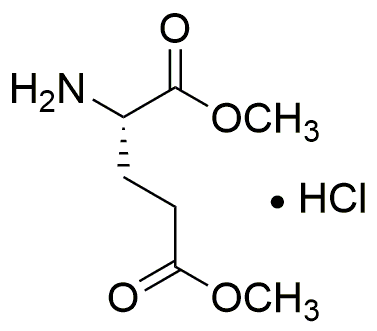L-Glutamic acid dimethyl ester hydrochloride is widely utilized in research focused on:
- Neuroscience Research: This compound serves as a key building block in the synthesis of neurotransmitters, aiding in studies related to brain function and neurodegenerative diseases.
- Pharmaceutical Development: It is used in drug formulation processes, particularly in creating compounds that target glutamate receptors, which are crucial in treating conditions like epilepsy and depression.
- Food Industry: As a flavor enhancer, it can be incorporated into food products to improve taste, appealing to manufacturers looking to enhance consumer satisfaction.
- Agricultural Applications: The compound is explored for its potential in developing fertilizers that promote plant growth by enhancing amino acid availability in soil.
- Biochemical Research: It is utilized in various biochemical assays and experiments, providing researchers with a reliable tool for studying metabolic pathways and enzyme activities.
General Information
Properties
Safety and Regulations
Applications
L-Glutamic acid dimethyl ester hydrochloride is widely utilized in research focused on:
- Neuroscience Research: This compound serves as a key building block in the synthesis of neurotransmitters, aiding in studies related to brain function and neurodegenerative diseases.
- Pharmaceutical Development: It is used in drug formulation processes, particularly in creating compounds that target glutamate receptors, which are crucial in treating conditions like epilepsy and depression.
- Food Industry: As a flavor enhancer, it can be incorporated into food products to improve taste, appealing to manufacturers looking to enhance consumer satisfaction.
- Agricultural Applications: The compound is explored for its potential in developing fertilizers that promote plant growth by enhancing amino acid availability in soil.
- Biochemical Research: It is utilized in various biochemical assays and experiments, providing researchers with a reliable tool for studying metabolic pathways and enzyme activities.
Documents
Safety Data Sheets (SDS)
The SDS provides comprehensive safety information on handling, storage, and disposal of the product.
Product Specification (PS)
The PS provides a comprehensive breakdown of the product’s properties, including chemical composition, physical state, purity, and storage requirements. It also details acceptable quality ranges and the product's intended applications.
Certificates of Analysis (COA)
Search for Certificates of Analysis (COA) by entering the products Lot Number. Lot and Batch Numbers can be found on a product’s label following the words ‘Lot’ or ‘Batch’.
*Catalog Number
*Lot Number
Certificates Of Origin (COO)
This COO confirms the country where the product was manufactured, and also details the materials and components used in it and whether it is derived from natural, synthetic, or other specific sources. This certificate may be required for customs, trade, and regulatory compliance.
*Catalog Number
*Lot Number
Safety Data Sheets (SDS)
The SDS provides comprehensive safety information on handling, storage, and disposal of the product.
DownloadProduct Specification (PS)
The PS provides a comprehensive breakdown of the product’s properties, including chemical composition, physical state, purity, and storage requirements. It also details acceptable quality ranges and the product's intended applications.
DownloadCertificates of Analysis (COA)
Search for Certificates of Analysis (COA) by entering the products Lot Number. Lot and Batch Numbers can be found on a product’s label following the words ‘Lot’ or ‘Batch’.
*Catalog Number
*Lot Number
Certificates Of Origin (COO)
This COO confirms the country where the product was manufactured, and also details the materials and components used in it and whether it is derived from natural, synthetic, or other specific sources. This certificate may be required for customs, trade, and regulatory compliance.


